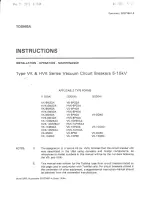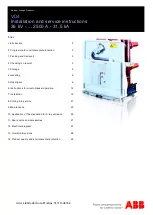
Levering Shaft
Interlock
Oscillator
Emergency
Charge Return
Spring
Hold Pawl
FRONT
(Close Springs Removed)
Main
Drive Link
R.H. Close
Spring
Spring Anchor
L.H. Close
Spring
REAR
Figure 3-13 Typical Front/Rear Views of Power Operated Spring Charge Mechanism
The drawout manually operated circuit breaker has four nor-
mal positions in its compartment, determined by the levering
device: REMOVE, DISCONNECT, TEST AND CONNECT.
Refer to Paragraph 2-5 for additional information.
3-8.2 Power Operated Circuit Breaker
On power operated circuit breakers, the closing springs can
be charged both electrically and manually. Normally, the
springs are automatically charged by a universal type electric
motor, which is part of the mechanism. If necessary, the
springs can be charged manually through the use of a front
mounted spring-charge handle. The spring charge handle
used with power operated circuit breakers is significantly
shorter than the handle used with manually operated circuit
breakers. Closing is accomplished electrically by an electro-
magnet which lifts the closing spring release latch. Like the
manually operated circuit breaker, the power operated circuit
breaker can also be closed manually by pushing on the front
control panel close bar (Figure 3-3).
Like the manually operated version, the power operated
circuit breaker can also be tripped open manually by pushing
the trip plate on the front control panel or the trip plate on
the circuit breaker compartment door.
Power operated circuit breakers can be electrically tripped
through the following devices:
•
Standard shunt trip device
•
Trip actuator energized from the elec
tronic trip unit
•
Optional undervoltage trip device
•
Blown limiter indicator on DSLII type breakers
3-9 Movable Primary and Secondary Contacts
The primary connection of a drawout circuit breaker to
the primary stabs in the breaker compartment is provided
by six primary disconnect finger clusters (Figures 3-1 and
3-2). Each finger cluster is comprised of a number of spring
loaded fingers. The number of fingers varies, depending
upon the current rating of the breaker. Finger clusters attach
to the primary studs of the breaker’s pole unit assembly.
Finger clusters can be easily removed using a finger cluster
removal tools.
Effective July 2010
Instructional Book
IB694C694-03
24
eaton corporation
www.eaton.com















































